What would your future-you have to say to you?
The no-pants guide to spending, saving, and thriving in the real world.
What would your future-you have to say to you?
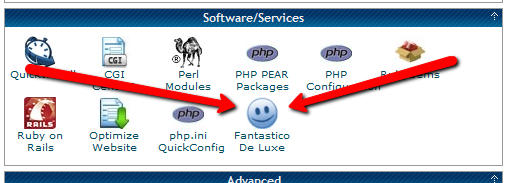
In this installment of the Make Extra Money series, I’m going to show you how to set up a WordPress site. I’m going to show you exactly what settings, plugins, and themes I use. I’m not going to get into writing posts today. That will be next time.
I use WordPress because it makes it easy to develop good-looking sites quickly. You don’t have to know html or any programming. I will be walking through the exact process using Hostgator, but most hosting plans use CPanel, so the instructions will be close. If not, just follow WordPress’s 5 minute installation guide.
Assuming you can follow along with me, log in to your hosting account and find the section of your control panel labeled “Software/Service”. Click “Fantastico De Luxe”.

On the Fantastico screen, click WordPress, then “New Installation”.
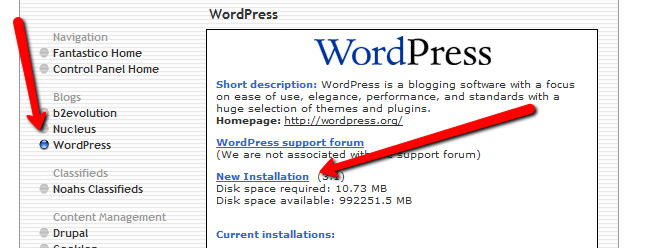
On the next screen, select your domain name, then enter all of the details: admin username, password, site name, and site description. If you’ll remember, I bought the domain http://www.masterweddingplanning.net. I chose the site name of “Master Wedding Planning” and a description of “Everything You Need to Know to Plan Your Wedding”.
Click “install”, then “finish installation”. The final screen will contain a link to the admin page, in this case, masterweddingplanning.net/wp-admin. Go there and log in.
After you log in, if there is a message at the top of the screen telling you to update, do so. Keeping your site updated is the best way to avoid getting hacked. Click “Please update now” then “Update automatically”. Don’t worry about backing up, yet. We haven’t done anything worth saving.
Next, click “Settings” on the left. Under General Settings, put the www in the WordPress and site URLs. Click save, then log back in.
Click Posts, then Categories. Under “Add New Category”, create one called “Misc” and click save.
Click Appearance. This brings you to the themes page. Click “Install Themes” and search for one you like. I normally use Headway, but before I bought that, I used SimpleX almost exclusively. Your goal is to have a simple theme that’s easy to maintain and easy to read. Bells and whistles are a distraction.
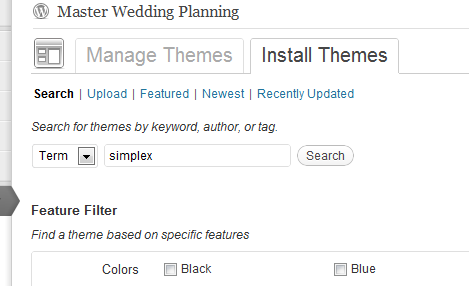
Click “Install”, “Install now”, and “Activate”. You now have a very basic WordPress site.
A plugin is an independent piece of software to make independent bits of WordPress magic happen. To install the perfect set of plugins, click Plugins on the left. Delete “Hello Dolly”, then click “Add new”.
In the search box, enter “plugin central” and click “Search plugins”. Plugin Central should be the first plugin in the list, so click “install”, then “ok”, then “activate plugin”. Congratulations, you’ve just installed your first plugin.
Now, on the left, you’ll see “Plugin Central” under Plugins. Click it. In the Easy Plugin Installation box, copy and paste the following:
All in One SEO Pack Contact Form 7 WordPress Database Backup SEO SearchTerms Tagging 2 WP Super Cache Conditional CAPTCHA for WordPress date exclusion seo WP Policies Pretty Link Lite google xml sitemaps Jetpack by WordPress.com
Click “install”.
On the left, click “Installed Plugins”. On the next screen, click the box next to “Plugins”, then select “Activate” from the dropdown and click apply.
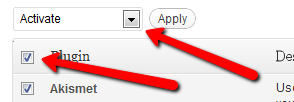
Still under Plugins, click “Akismet Configuration”. Enter your API key and hit “update options”. You probably don’t have one, so click “get your key”.
The only tool I worry about is the backup. It’s super-easy to set up. Click “Tools”, then “Backup”. 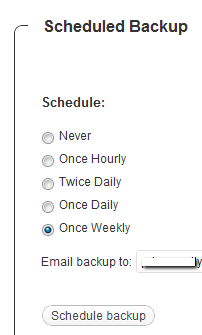
Scroll down to “Schedule Backups”, select weekly, make sure it’s set to a good email address and click “Schedule Backup”. I only save weekly because we won’t be adding daily content. Weekly is safe enough, without filling up your email inbox.
There are a lot of settings we’re going to set. This is going to make the site more usable and help the search engines find your site. We’re going to go right down the list. If you see a section that I don’t mention, it’s because the defaults are good enough.
Set the Default Post Category to “Misc”.
Visit this page and copy the entire list into “Update Service” box. This will make the site ping a few dozen services every time you publish a post. It’s a fast way to get each post indexed by Google.
Click “Save Changes”.
Uncheck everything under “Email me whenever…” and hit save. This lets people submit comments, without actually posting the comments or emailing me when they do so. Every once in a while, I go manually approve the comments, but I don’t make it a priority.
Select “Custom structure” and enter this: /%postname%/
Click save.
Set the status to “Enabled”, then fill out the site title and description. Keep the description to about 160 characters. This is what builds the blurb that shows up by the link when you site shows up in Google’s results.
Check the boxes for “Use categories for META keywords” and “Use noindex for tag archives”.
Click “Update Options”.
Check the boxes to remove each of the dates and set the alt text to “purpose” or something. This will suppress the date so your posts won’t look obsolete.
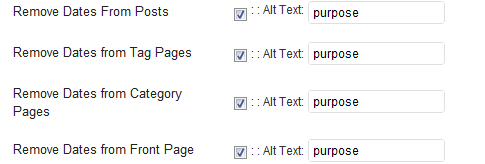
This plugin reinforces the searches that bring people to your site. It’s kind of neat. Skip the registration, accept the defaults and hit save.
Scroll to the bottom and click import. We’ll come back to this.
Select “Caching On” and hit save.
Across the top of the screen should be a giant banner telling you to connect to WordPress.com and set up Jetpack. You’ll need an account on WordPress.com, so go there and set one up. After authorizing the site, you’ll be brought back to the Jetpack configuration screen. Click “Configure” under “WordPress.com Stats”. Take the defaults and hit save.
On the contact configuration page, copy the code in the top section. You’ll need this in a moment.
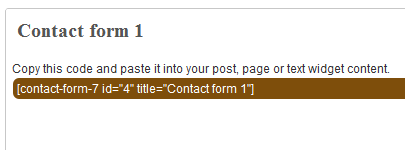
Now, we going to create a couple of static pages. On the left, click “Pages”, then “Add new”.
Name the first page “Contact” and put the contact form code in the body of the page. Hit publish.
Under Appearance, click “Menu”. Enter a menu name and hit save.
Then, under “Pages”, click the box next to “Contact”, “Disclaimer”, and any other policies you’d like to display. Hit save.
Also under Appearance, click “Widgets”. This is where you’ll select what will display in the sidebar. All you have to do is drag the boxes you want from the middle of the page to the widget bar on the right. I recommend Text, Search, Recent Posts, Popular Search Terms and Tag Cloud. In the text box, just put some placeholder text in it, like “Product will go here”. We’ll address this next time.
We’re not going to worry about getting posts in place, yet. That will be the next installment. However, the steps in the next installment could take 2 weeks to implement, and we want Google to start paying attention now. To make that happen, we need to get a little bit of content in place. This won’t be permanent content. It’s only there so Google has something to see when it comes crawling.
To get this temporary, yet legal content, I use eZineArticles. Just go search for something in your niche that doesn’t look too spammy.
Then, click “Posts”, then delete the “Hello World” post. Click “Add new”. Copy the eZine article, being sure to include the author box at the bottom, and hit publish.
To see your changes, you may have to go to Settings, then WP Cache and delete the cache so your site will refresh.
Congratulations! You now have a niche blog with content. It’s not ready to make you any money, yet, but it is ready for Google to start paying attention. In the next installment, I’ll show you how I get real unique content and set it up so Google keeps coming back to show me the love.

…err, no more car loan. I paid off my car this week, a year early! Now I’m down to 2 debts: a credit card with an embarrassingly high balance and my mortgage. We’re rocking the debt snowball!
INGDirect is having a sweet promotion. Open a checking account, use it three times in 45 days, and get $50 free. Free money is the best kind. I love my ING account and keep all of my savings there. If you don’t have an account there, yet, now is a great time to open one.
This month, I am trying to establish the Slow Carb Diet as a habit. At the end of the month, I’ll see what the results were and decide if it’s worth continuing. For those who don’t know, the Slow Carb Diet involves cutting out potatoes, rice, flour, sugar, and dairy in all their forms. My meals consist of 40% proteins, 30% vegetables, and 30% legumes(beans or lentils). There is no calorie counting, just some specific rules, accompanied by a timed supplement regimen and some timed exercises to manipulate my metabolism. The supplements are NOT effedrin-based diet pills, or, in fact, uppers of any kind. There is also a weekly cheat day, to cut the impulse to cheat and to avoid letting my body go into famine mode.
I’m measuring two metrics, my weight and the total inches of my waist , hips, biceps, and thighs. Between the two, I should have an accurate assessment of my progress.
Weight: I have lost 17 pounds since January 2nd. That’s 6 pounds since last week. I cheated this week and had a slice of toast and 6 croutons with my grilled chicken-but-no-cheese salad.
Total Inches: I have lost 9 inches in the same time frame, down 3.5 since last week.
Naturally, the first week is the most dramatic. That’s when my body was flushing most of the garbage I’d been eating, including holiday feasts. I’ll have a hard time complaining about 6 pounds in a week. My guess is that I drop another 10-15 pounds by the end of the month, bringing the average to about 1 pound per day. Over time, that will drop as my base caloric burn drops to match my new weight.
Realized Returns is giving away a Kindle. I would greatly appreciate it if you didn’t enter, because I’d love to get a Kindle.
Maximizing Money has put together a stellar list of financial blogs. If I’m not enough to keep you going, take a look at that list.
Mystery shopping sounds like it could be such a sweet deal for some people. Always try to make money doing what you love.
Here is another list of sites that can make you some money. I love side hustles.
And finally, here is Lifehacker, showing you how to make better cocoa.
This is where I review the posts I wrote one year ago.
I wrote a post on saving money while cooking. This post has easily withstood the test of time. We keep getting better at stretching our budget. Over the last year, we’ve actually reduced our food budget by an additional $50 per month, while the quality of our meals has gone up.
This was the first week I posted a 30 Day Project update. My first goal was to start waking up at 5AM. That worked well for almost the entire year, but I’ve let that slack off over the last few months. On the weekends, I don’t set an alarm or try to get up early, but I’m still up by 7:30, usually. During the week, my alarm goes off at 5:10, but I let myself snooze it. I’ve discovered that I do better at attending to my personal projects(like blogging) late at night instead of early in the morning. So, I’m going with what works, instead of trying to force what doesn’t.
I also reviewed the bills I pay that aren’t paid monthly in my third budget lesson.
First 3 Things to Do in the New Year was included in Crystal’s rockin’ new Total Money Carnival.
4 Ways We Keep Wasting Money was included in the Festival of Frugality.
Living the XBox Life on an Atari Income was included in the Carnival of Personal Finance.
Swamp Finance was hosted by Squirrelers.
I ran the guest post, The Best Financial Advice I Ever Received for Saving Money Today.
Thank you! If I missed anyone, please let me know.
There are so many ways you can read and interact with this site.
You can subscribe by RSS and get the posts in your favorite news reader. I prefer Google Reader.
You can subscribe by email and get, not only the posts delivered to your inbox, but occasional giveaways and tidbits not available elsewhere.
You can ‘Like’ LRN on Facebook. Facebook gets more use than Google. It can’t hurt to see what you want where you want.
You can follow LRN on Twitter. This comes with some nearly-instant interaction.
You can send me an email, telling me what you liked, what you didn’t like, or what you’d like to see more(or less) of. I promise to reply to any email that isn’t purely spam.
That’s all for today. Have a great weekend!
Ever since she was a little girl, my wife has wanted to be a horse. Err, work with horses.

The problem is that most jobs working with horses pay horse-crap. It’s hard to raise a family on a stablehand’s income.
Her alternative was to own horses. This comes with a different set of problems. The biggest problem is that we live on 1/8 of an acre in a first-ring suburb. That’s not a lot of room to graze, though I would be willing to give up my spot in the garage.
I rock like that.
Boarding a horse costs a minimum of $200 per month. Two girls means two horses, otherwise, they won’t both be able to score in the saddle club. For the math challenged, that’s $400 per month, plus about $300 in preventative vet care per year.
$5100 for a year of boarding an extremely obsolete car.
Then, you need a trailer to get the horse to shows. You need saddles and reins and and short-legged stirrups and feedbags and muck-rakes and brushes and combs and hoof-cleaning-thingies and other stuff that will catch me by surprise for years to come.
Expensive.
My rough estimate is that it costs at least $10,000 to get into horse ownership, and that’s not counting the horse itself.
You can buy a horse for well under $1000 if you aren’t concerned about registration or speed. A 15 year old horse can last 10-15 more years, so it’s not money down the drain.
That’s $12,000 to get in and $5100 per year to stay in. Minimum.
Never let it be said that I’m not a pushover. Last month, we bought an SUV that can pull a horse trailer. Last weekend, we bought the trailer. That’s two major steps towards making my wife’s dreams come true. The rest of the plan culminates in a hobby farm in the sticks.
There are several steps in between.
I just need to put the brakes on every other step. We’ve been offered the free use of one pony next season, and we may be able to get another for the same price. Beyond that, we need to be patient. There will be no ponies purchased until the new truck and old mortgage are paid.
Period.
Today, I am continuing the series, Money Problems: 30 Days to Perfect Finances. The series will consist of 30 things you can do in one setting to perfect your finances. It’s not a system to magically make your debt disappear. Instead, it is a path to understanding where you are, where you want to be, and–most importantly–how to bridge the gap.
I’m not running the series in 30 consecutive days. That’s not my schedule. Also, I think that talking about the same thing for 30 days straight will bore both of us. Instead, it will run roughly once a week. To make sure you don’t miss a post, please take a moment to subscribe, either by email or rss.
On this, Day 6, we’re going to talk about cutting your expenses.
Once you free up some income, you’ll get a lot of leeway in how you’re able to spend your money, but also important–possibly more important–is to cut out the crap you just don’t need. Eliminate the expenses that aren’t providing any value in your life. What you need to do is take a look at every individual piece of your budget, every line item, every expense you have and see what you can cut. Some of it, you really don’t need. Do you need a paid subscription to AmishDatingConnect.com?
If you need to keep an expense, you can just try to lower it. For example, cable companies regularly have promotions for new customers that will lower the cost to $19 a month for high-speed internet. Now, if you call up the cable company and ask for the retention department, tell them you are going to switch to a dish. Ask, “What are you willing to do to keep my business?” There is an incredibly good chance that they will offer you the same deal–$20 a month–for the next three or four months. Poof, you save money. You can call every bill you’ve got to ask them how you can save money.
I called my electric company and my gas company to get on their budget plans. This doesn’t actually save me money but it does provide me with a consistent budget all year long, so instead of getting a $300 gas bill in the depths of January’s hellish cold, I pay $60 a month. It is averaged out over the course of the year. It feels like less and it lets me get a stable budget. Other bills are similar. You can call your credit card companies and tell them everything you take your business to another card that gave you an offer of 5% under what ever you are currently paying. It doesn’t even have to be a real offer. Just call them up and say you are going to transfer your balance away unless they can meet or beat the new interest rate. If you’ve been making on-time payments for any length of time–even six months or a year–they’re going to lower the interest rate business, no problem. Start out by asking for at least a 5% drop. In fact, demand no more than 9.9%.
Once you’ve gone through every single one of your bills, you’ll be surprised by how much money you’re no longer paying, whether it’s because somebody lowered the bill for you or you scratched it off the list completely.
I spent most of last week at the Financial Blogger Conference, or FINCON.
First, since this is a personal finance blog, here is what it cost:
Hotel: $695.75 – I paid $119 per night, plus taxes and fees. The travel rewards on my credit card will be making this go away.
Airfare: $211.80 – I bought early and live next to a Delta hub airport. This will also be getting erased by my credit card rewards.
Ticket: $175.84 – I got a $25 discount for being a repeat attendee and I paid an extra $99 for the Bootcamp extension, which was 2 extra days that–alone–made the whole trip worthwhile.
Food: $203.53 – This includes a $90 splurge meal at Ruth’s Chris, which I was looking forward to for months before the conference.
Other – $113 – I brought $183 in cash with me. This was used for some meals not included above, cab fare, and tips for bartenders, housekeeping, and the concierge. I always tip a bartender, even if it’s an open bar. It guarantees fast service and full-strength drinks all night.
Total cost: $1399.92
Total after credit card reimbursement: $492.37
Now for the important part: Was it worth it?
Yes.
The Bootcamp was a fantastic time to meet–and actually get to know–other bloggers. There were only 50 of us, instead of 500 at the main event, so we were able to break into small groups and brainstorm useful projects and activities. I learned more about podcasting than I ever had before and I got a chance to share some of what I know about SEO and managing virtual assistants. In the larger sessions, questions are rushed and people are shy.
I got to beat up on my comfort zones.
I presented some awards with Crystal at the Plutus Awards ceremony, which means cracking jokes about Canadians in front of 500 people who don’t know me. I regularly stand and teach 30-50 people, but that’s always a warm crowd on a topic I know extremely well. This was new for me.
I sang anatomically explicit songs to strangers during the Bootcamp karaoke night. Selections were from Monty Python, DaVinci’s Notebook, and Denis Leary.
I was on a panel, by surprise. I was asked to be available if I were needed for questions, then got dragged to the front of the room for the entire session. I would do that again.
That’s 3 things that were all well outside of my comfort zone, but I’m happy I did them. I don’t believe in not doing something simply because I’m afraid to do it.
Random gatherings are fun.
From people stopping by our staked-out territory in the lobby, to a surprise game of Cards Against Humanity in the lobby bar with Joe and Len to having a discussion about the meaning of “No” when you’ve got a pre-determined safeword, it was a good week.
The last 5 days were easily the most extroverted days I’ve ever had. Since I didn’t force myself into any large groups for long periods of time, I never felt drained like I often do in similar situations. It’s good to find a balance that let’s me meet and connect with other without exhausting myself. I am seriously an off-the-charts introvert, even if I’m not even a little bit shy.
FINCON was totally worth it. I was excited to go, and I’m excited to start acting on what I’ve learned, including being a part of a new mastermind group, with the awesomest lounge lizards in the PF world.